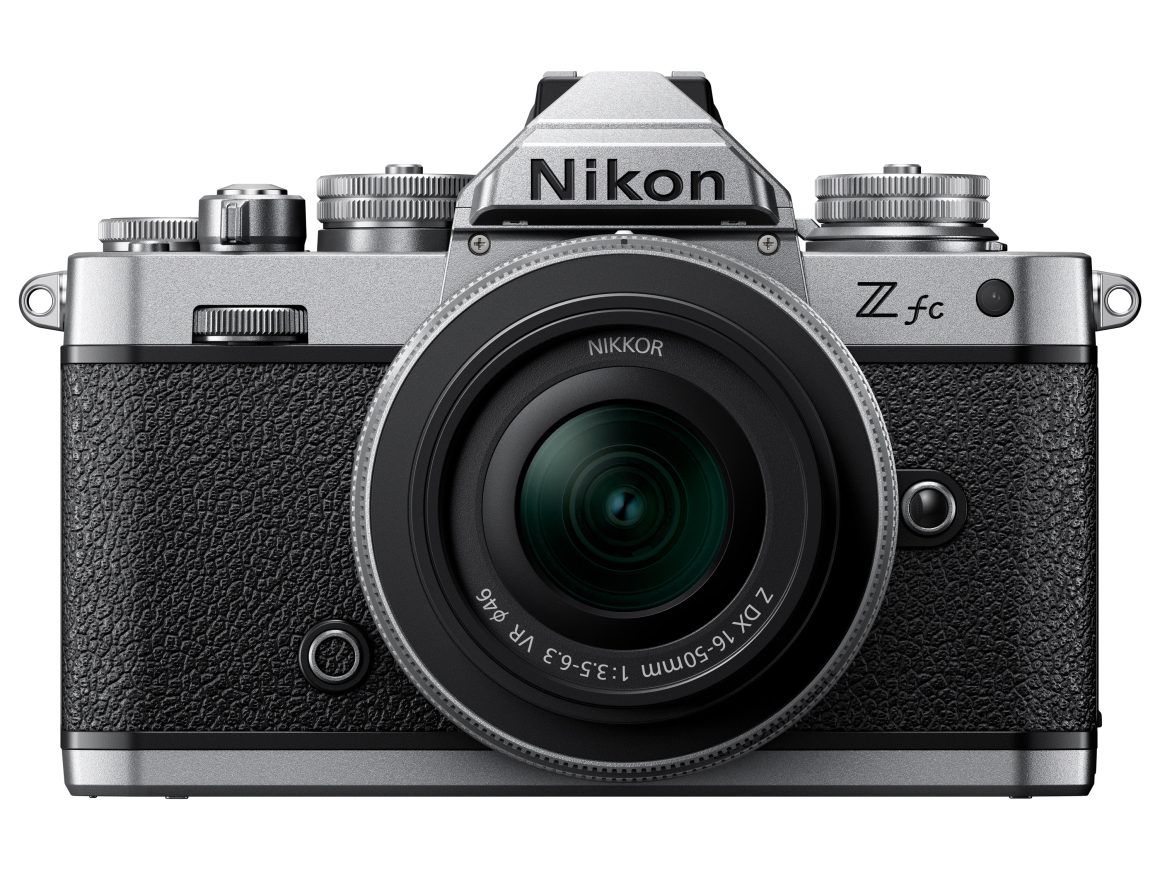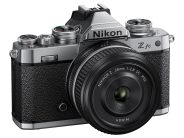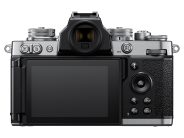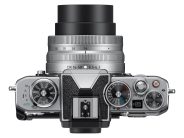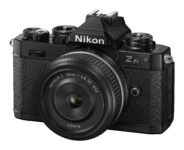Nikon Z fc
APS-C AF digital mirrorless camera
Specification
| Production details: | |
| Announced: | June 2021 |
| System: | ● Nikon Z APS-C (2019) |
| Format: | |
| Maximum format: | APS-C |
| Imaging sensor: | 23.5 × 15.7mm CMOS sensor |
| Resolution: | 5568 × 3712 - 21 MP |
| Crop factor: | 1.53x |
| Sensor-shift image stabilization: | - |
| Mount and Flange focal distance: | Nikon Z [16mm] |
| Shutter: | |
| Type: | Focal-plane |
| Model: | Electronically controlled |
| Speeds: | 900 - 1/4000 + B |
| Exposure: | |
| Exposure metering: | Through-the-lens (TTL), open-aperture |
| Exposure modes: | Programmed Auto |
| Aperture-priority Auto | |
| Shutter-priority Auto | |
| Manual | |
| Physical characteristics: | |
| Weight: | 445g |
| Dimensions: | 134.5x93.5x43.5mm |
Manufacturer description #1
MELVILLE, NY (June 29, 2021) – Today, Nikon announced the Z fc, a DX-format camera that combines the latest mirrorless technology with classic design and functionality. It’s the compact and lightweight everyday companion that evokes both the urge to create and to take the time to embrace the moment. Featuring a heritage-inspired design, satisfying analog controls and craftsmanship that’s both unique and functional, the Z fc is built to be a thoroughly modern camera that’s simply a joy to use for everything from stunning street snaps, self-portraits, vlogging or 4K UHD video content. Nikon has also announced two stylized lenses to complement the compact nature and aesthetic of the camera, plus additional NIKKOR Z lenses coming this year with a focus on small size and big performance.
“The Z fc is the kind of camera many have been waiting for, and that only Nikon could create. It’s exceptionally slim, yet offers superb image quality and features, with iconic styling and precise tactile controls. It’s a joy to carry and use for casual street photography, streaming, or just living in the here and now,” said Jay Vannatter, Executive Vice President, Nikon Inc. “It’s no coincidence that we are also announcing a variety of compact lenses alongside the camera to perfectly complement the iconic aesthetic.”
Fusion of Classic Design + Z Series Technology
The Z fc embraces both Nikon’s heritage and our future with the powerful Z mount to create something truly beautiful; it’s a distinctly designed camera that has the performance to keep pace, but also serves as a reminder to appreciate the moment.
An Iconic Design: Inspired by the popular Nikon FM2 film SLR, the camera affords shooting with analog tactile dials with satisfying clicks for precise control. The compact and lightweight camera gives enthusiasts and casual photographers alike the option to explore their creativity and go fully automatic or manual with mechanical dials for shutter speed, ISO and exposure compensation.
Meticulously Crafted: The exterior of the camera is wrapped in a leather-tone material that offers an impeccably premium feel with a thoughtful blend of black and satin silver elements. It’s a familiar design that focuses on the harmony of style and functionality, with intricate details like carved aluminum dials, engraved lettering and a circular eyepiece surrounding the bright electronic viewfinder.
Explore New Angles: The Vari-Angle touchscreen LCD flips out to face the user and automatically adjusts for self-portraits, working on a tripod or holding at waist level for creative angles.
High Resolution: 20.9-MP CMOS sensor is paired with the EXPEED 6 engine to provide clean, professional quality videos and stills, even in low light. From a sunny hike or twilight cityscape, users will appreciate exceptional clarity, magnificent color reproduction and minimal noise in nearly any situation.
Focus Fast: The 209-point hybrid AF system has you covered, recognizing approximately 87% of the frame horizontally and 85% vertically for precise focusing and tracking throughout more of the frame. Rapid Eye-Detection AF for people and animals enable users to sharply capture the eyes of people and pets, even when they’re moving. Eye-Detection AF is also now available in the wide-area AF (L) mode, making it easy to select the area to prioritize focus.
Advanced Video Features: The Z fc has convenient video features creators want, like 4K UHD video and a variety of frame rates. Focus is rapid yet smooth, with full-time AF that locks onto eyes and faces in the frame. Slow motion can easily be created with the 1080p/120p setting or the 4x/5x in-camera slow motion modes. A built-in interval timer also allows for the convenient creation of 4K timelapse movies.
Keep Streaming: When connected via USB-C, the camera receives power, giving the ability to operate the camera continuously, which is beneficial for streaming, video production, timelapse creation and more. The Nikon Webcam Utility is available as a free download for all users of the Z fc and many other Nikon cameras.
The Z fc is Designed Around Nikon’s Revolutionary Z Mount: The widest lens mount of any comparable camera system means more light, and more light means more sharpness, contrast, accurate focus, low light performance and image quality.
Low Light Ability is at Your Fingertips: When operating the dedicated ISO dial, discover photos and videos with minimal noise, clear details and texture. The ISO sensitivity ranges from 100 up to 51,200*1 (expandable up to 204,800), allowing for faster shutter speeds in lower light to reduce blur and reveal striking nighttime visuals.
Creativity Made Easy: The Z fc can operate in fully automatic mode, and users can use the exposure compensation dial in auto mode to quickly adjust brightness for a custom look. Users also have access to 20 picture controls to add creative or dramatic flair and emphasis to images and video.
Always Connected with Nikon SnapBridge*2: Automatically send photos and videos to your phone or tablet for sharing, or use Nikon SnapBridge app as a remote control. The camera’s firmware can also be updated directly from the app.
Premium Construction: The classic design is built with a lightweight magnesium alloy frame with consideration to dust and drip resistance. The extraordinarily small and flattened profile is convenient to carry and fits easily into bags. The controls are well thought out, with most settings available at a glance, including aperture through the top display panel.
Choose Your Style: In addition to the retro black and silver, the Z fc will be available in six additional color options to vibe with any personal style; white, coral pink, mint green, sand beige, amber brown and natural gray.
Manufacturer description #2
November 8, 2022
NIKON ANNOUNCES NEW NIKKOR Z 40MM F/2 (SE) SPECIAL EDITION LENS WITH A TIMELESS DESIGN
Nikon Also Announces Exclusive Black Edition of the Retro-Inspired Nikon Z fc Mirrorless Camera
[...]
Nikon Z fc Black Edition
Nikon has also announced a new stylized version of the Nikon Z fc, which is now available as an all-black edition as a respectful homage to the original color schemes. The Z fc is a mirrorless camera with a design that evokes the essence of the legendary FM2 film camera, and this new design will surely appeal to those who appreciate subtle minimalism.
The Z fc is a compact and lightweight mirrorless camera, offering all the benefits of modern technology combined with stylish and satisfying precision carved analog dials. It features a 20.9-megapixel APS-C sensor for amazing image quality even in low light, combined with advanced technology such as full time Eye-Detection AF, 4K 30p video capture, and a vari-angle vlogger-style LCD screen to creatively compose. The Z fc makes it simple and fun to capture your content; users can embrace full manual control, or use the powerful automatic settings to easily capture stellar photos and videos that get noticed.
The Z fc is also currently available in the attractive black and silver scheme, as well as additional stylish colors including Amber Brown, White, Natural Gray, Sand Beige, Coral Pink and Mint Green.
